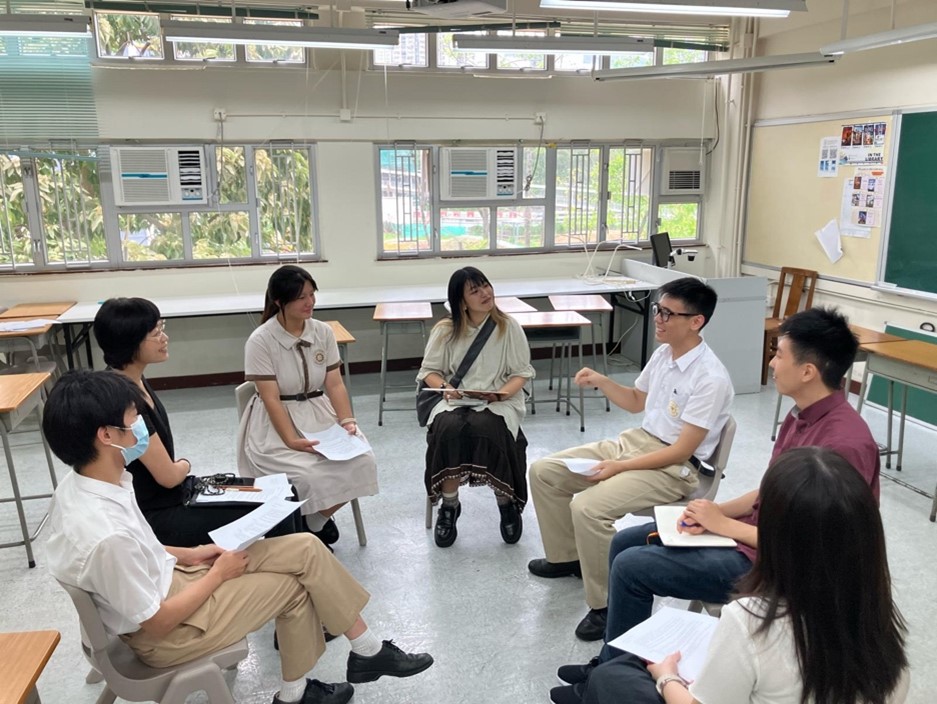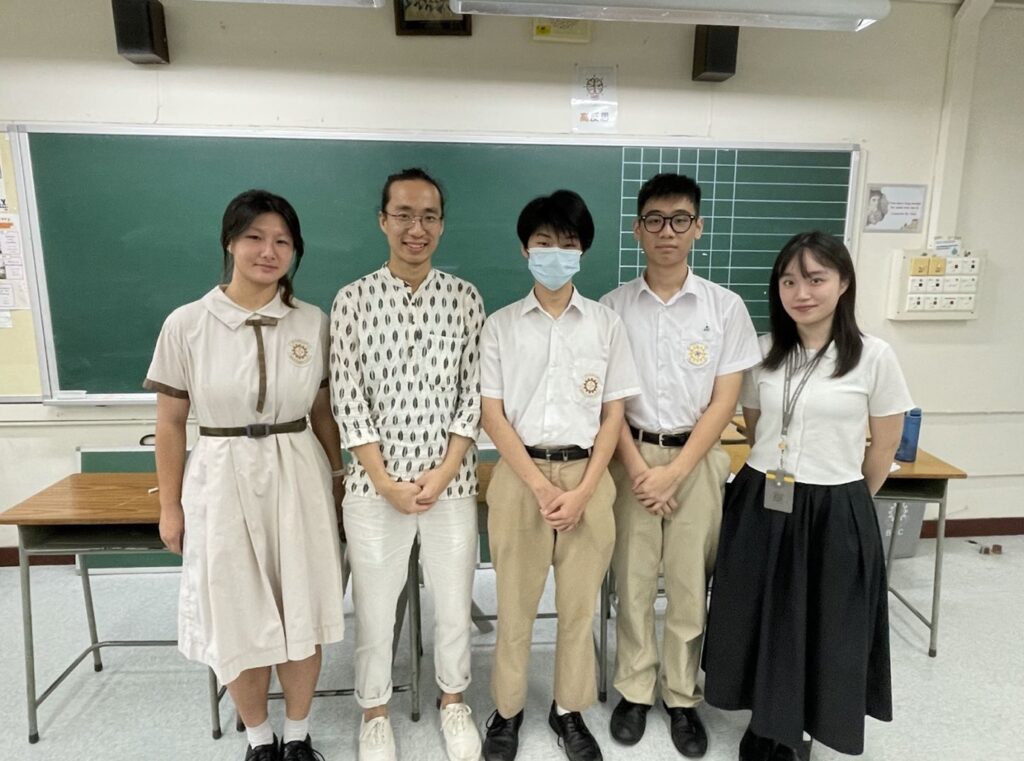
香港的青少年群體正面臨著嚴重的心理健康危機。根據2023年香港基督教服務處的研究結果,逾七成學生認為「學業問題」為導致自殺的主要原因。此外, 家庭因素、人際交往等問題,也給青少年帶來了諸多壓力。研究更指出,有約九成人面對負面情緒時,沒有向老師、社工或家人求助。
青少年感到疏離、焦慮甚至抑鬱。他們的健康狀況引起我們的關注,須要採取行動,為青少年提供安穩的內在心靈狀態,以及應對及解決衝突的資源,來解決香港青少年正陷入身心靈健康危機這個迫切的問題。
正是在這樣的背景下,由中大文化及宗教研究系周博士的社企SouLight Spiritual Education Centre應運而生,團隊導師通過「內在和平與外在和平」課程,走進年輕人的內心世界,提供安全、包容的空間,給予他們面對衝突和困境的智慧,為受到身心靈困擾的青少年帶來療癒(healing)與轉化(transformation)。
朋輩壓力——中學生的心理困擾
走入窗明几淨的班房時,放學鈴已經響起。學生三三兩兩走出學校,目光不時投向仍亮著燈的班房。班房內,來自佛教沈香林紀念中學的天天、思翰和小芸,正將心事娓娓道來。中四的他們,面臨著各種各樣的問題。
「我認為在學校最大壓力來自於同學和朋友。有人溫書三個鐘,都有人溫書六個鐘,每個人都很勤力,在這樣的對比之下,我就顯得好懶。」在思翰看來,學業上的壓力來自朋輩,使得他總會將目光放在他人身上,與他人比較,無法專注自我。
另一位同學天天補充,朋輩壓力不僅因為學業成績,也因為人際關係的相處。天天坦言:「我和一個同學關係非常差,他總是反對我的觀點,我們經常發生爭執。」無獨有偶,女同學小芸也面臨著同樣的問題。處於青春期的她,時常感到自卑,會因為擔心自己的外貌產生焦慮。她說:「同學是令我感到自卑和焦慮的原因。」敏感的她會因同學的言語、「玩笑」或是矛盾不斷內耗,續而對自己產生懷疑。
事實上,朋輩間的相處一直是青少年群體面對的重大挑戰。同處一個校園中,有人內向羞澀,與他人相處存在障礙;有人則缺乏同理心,難以化解矛盾。這些都給他們的心理健康帶來了沉重負擔。

溫馨的家——也難解心中煩惱
除朋輩關係之外,三位同學還分享到共同的家庭生態:在家人面前,他們會舉出笑臉,卻把悲傷掩藏。
「我不希望媽媽擔心,」這是小芸時常掛在嘴邊的話。與父母關係良好的她,為避免父母擔心,將煩惱和心事都藏在心底,遇到無法解決的問題,也是關上房門,獨自面對,而不願與家人傾訴心中苦惱。「我感覺內心有一堵高牆,沒有人理解我,我也把自己鎖起來。」
而活潑懂事、時常調解同學矛盾、班中的「和平領袖」思翰,內心也有著無人傾訴的煩惱。「我就是照顧家裏的那一個。」在家中排行第二的他,既要照顧年幼的弟弟,也要關照就讀大學的哥哥,而他自己的煩惱,卻只能深埋心底,無人傾聽。他說:「我最大的願望是找到一個樹窿。」
心靈教育——學會找到內外的和平
在他們最需要關懷的時候,「翟Sir」帶著「內在和平與外在和平」課程出現。八節課堂中,學生通過聆聽故事、扮演角色等教學活動,更加了解如何與自己相處,找到內心平衡。同時,他們也學會代入他人視角,設身處地思考問題,提升同理心,促進與他人的良性互動。
「翟Sir特別有趣,他用溫柔的交流方式,氛圍很輕鬆。」天天十分喜歡翟Sir的課堂。在心靈教育課程後,他開始學著在人際關係中更加為人著想。比如在小組作業時給予成續落後的同學鼓勵:「雖然在這一部分可能做得不好,但在其他方面你都好優秀,」使對方不必心灰意冷。
小芸則笑著表示,心靈教育課後,她變得沒那麼容易哭了,內心狀態變得更穩定。「之前幾乎每天都哭,現在已經半年沒哭了」。小芸也分享課程對她處理內心感受方式的改變。課堂上翟Sir帶領他們思考「如果我是故事中的人物,我會怎樣選擇」,讓她慢慢覺察如何思考和選擇,亦會繼續努力嘗試,慢慢將心中的煩惱講出來。
心靈教育在世界各地的實踐
事實上,在世界其他地區,心靈教育早已成為一種備受關注的教育方式。美國是心靈教育發展最為成熟的國家之一。早在三十年前,美國就開始在學校推行「社交情感教育」(Social&Emotional Learning)課程,希望從最基本的自我認識開始,讓學生掌握自我覺察(self-awareness)與自我管理(self-management)的能力,進而學會社會覺察(social awareness)和人際技巧(relationship skills),做出負責任的決定(responsible decision-making)。
在亞洲,日本的心靈教育更是在全國中小學中普及,教師會引導學生沉浸在自然環境中,體驗內心的平靜與和諧。此外,佛教大國泰國還在全國推行「冥想教育」,讓學生通過冥想,找到心靈的慰藉。
採訪的尾聲,翟Sir邀請筆者、老師與三位同學,共同閉眼冥想,並在歌聲中感受自己、感受彼此。窗外,樹葉在風中搖動帶來沙沙聲,輕鐵穿過軌道發出轟鳴聲;窗內,呼吸安寧,歌聲平靜。香港的心靈教育或許將與青少年共同成長,並為青少年覓得一方療癒之所。
文: 王梓萌



